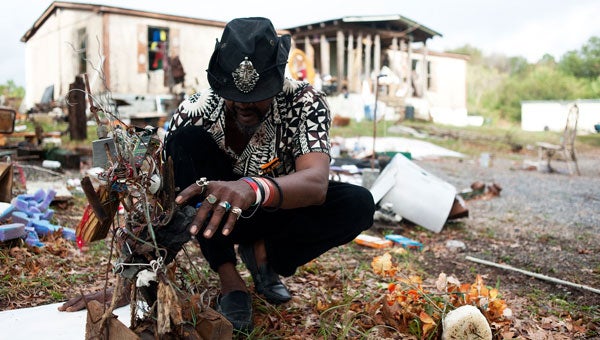PROFILE: Mister Sandman
Published 2:00 pm Wednesday, March 2, 2011

Holley works on one of the many assemblages in his yard. Placing wood, wires, twigs and hardware together, he creates a piece that represents the great minds in America. (Reporter photo/Jon Goering)
By KATIE HURST/ Lifestyles Editor
Driving past the home of Lonnie Holley in Harpersville, it’s easy to overlook the rundown trailer and beat up brown van that lay discarded among the pine trees along the dirt drive. What brings a second glance are the tattered quilts hanging from low tree limbs, the boards of plywood adorned with colored paintings and the pieces of junk and discarded appliances neatly assembled into chaotic sculptures throughout the yard.
A large sculpture of a human profile near the house is carved from yellow foam and stands five feet tall. Other items such as electrical wire, a light fixture, railroad wood and strands of a mop are tied together and dangle from tree branches.
Holley’s house sits on one lot, but his art knows no border line and sprawls out into the surrounding land and forest.
Holley calls the items in his yard “found materials” and he uses them to craft sculptures and assemblages that represent broader human issues. To Holley, every piece of junk has a message. Items that were once lying beside the railroad tracks or tossed in a ditch in downtown Birmingham transform into meaningful pieces of art in Holley’s skilled hands.
What on the outside might look like an eyesore to some, is in fact the home of a man whose work can be found in art museums around the world, including the Smithsonian and the gardens of the White House.
Much like his artwork, Holley also managed to transform the meager beginnings of his life into a masterpiece story of a man and artist who has overcome.
In the beginning
The story of this eccentric artist begins in 1950 when Holley was born in Birmingham, the seventh of 27 children.
“My mother had six kids before me,” Holley said. “When I was 1 and a half she gave me to a woman who took me away from Alabama.”
Much of his early childhood is unknown, but Holley said at the age of 4 he was sold to a woman at the Alabama State Fairgrounds for a pint of whiskey.
“I grew up out near the state fairgrounds and the drive-in theater was right across the ditch from my house,” he said. “I started picking up paper when I was 5 years old. I started learning about human behavior by watching every movie that came on at the drive-in sitting on top of the house. I was learning at a very early age what is now my art, but I didn’t know it then.”
When Holley was 7, the woman he lived with died in her bed at home. He said her husband was not home when it happened, and blamed Holley for killing his wife.
“Her husband was beating me and whipping on me, claiming I had killed her,” he said. “Every day I would get a whooping. One day after getting a beating, I took a wagon and ran across the street and got hit by a car. It drug me under the car for two and half blocks. I was unconscious and they said I would be brain dead.”
Miraculously, Holley recovered from the accident. After an adolescence spent among foster homes and corrections facilities in Alabama and New Orleans, eventually Holley was taken in by his maternal grandmother in Birmingham, who reunited him with his family.
In 1979, his sister lost two of her children when they died in a house fire. The family couldn’t afford tombstones for the children, so Holley carved grave markers out of sandstone he collected from a nearby foundry.
“It really started something in my life,” he said. “I didn’t know it would excel to the point it has. It stuck in my mind in a way I didn’t understand. I did not know about art, I didn’t even know how to spell art.
“My artwork is to show people how thankful I am to get to use my brain in any way I can,” he added. “I didn’t know it would take me to the Smithsonian, but that’s how it happened.”
A folk artist is born
After carving the baby tombstones, Holley continued making art by carving sandstone. Soon he progressed to using other materials he found from the earth, or littered on top of it. He started building assemblages in his yard, sculptures made of found materials – scraps of wood, strings from a mop, loose hardware and electrical wires. All Holley’s pieces have a meaning, whether describing environmental issues, human struggles or the evils of HDTV.
In 1981, Holley approached Richard Murray, the then-director of the Birmingham Museum of Art, with examples of his sandstone sculptures. Murray put several of Holley’s pieces on display in the museum and introduced his work to the curator of the Smithsonian American Art Museum. Two of his pieces were included in the Smithsonian exhibit “More Than Land and Sky: Art from Appalachia.”
“That made me so proud,” Holley said. “I started doing things with that in mind, that I was doing things for the greater art community.”
Holley was soon being praised as a self-taught, Southern-grown folk artist and his work was being acquired by the American Folk Art Museum in New York and the High Museum of Art in Atlanta.
During this time, Holley was living on a hilltop property near the Birmingham airport. He said the land surrounding his home had more than 3,500 pieces of artwork covering the grass and entwined in the trees.
In the late ’90s, during the Birmingham airport expansion project, Holley was informed his property would be condemned. After a long court battle with the airport authority, Holley moved to his current home in Harpersville and started over.
“It’s just what I had to do to endure,” he said. “I had to continue my work because my work was more important than my life situation.”
The Sandman
Though today Holley’s work can be found in art galleries throughout the world, his name hailed by art critics and his story told in publications such as The New York Times, his day-to-day life hasn’t changed much since he carved his first baby tombstone.
After 30 years of serving the art community, he still wanders the streets of downtown Birmingham searching out material for his work. He works everyday in his yard, murmuring to himself as his hands work a pocketknife over the rough surface of sandstone, creating the profile of an African-American child’s face.
His black hair and beard have begun to turn gray, but his fingers are still adorned with the gold rings and trinkets of his youth, his fingernails kept long and slender.
After moving to Harpersville, Holley started visiting local schools to give art lessons to students. He always brought sandstone to carve and the children in the area soon nicknamed him “The Sandman.”
Holley is still often found at local festivals in Shelby County and the Birmingham area, where he’s more than happy to carve a sandstone sculpture while telling his story to anyone who passes by.
These days he’s venturing out into new mediums in an attempt to express himself in new ways. He often works with computers now, using programs such as Paint and Photoshop to draw digital pieces of art.
He’s also moved from folk art to folk music and is working on recording an album.
“I sing about my life, of what I’ve had to endure,” he said. “Or I may sing about stormy weather, what’s in the clouds, what’s in the rain.”
Holley now has 15 children of his own along with grandchildren and great-grandchildren. Holley said he considers himself blessed by all the family in his life.
“They come around me and look around at how busy the mind of their grandfather is,” he said. “I tell them their minds are busy.”
Though some have called him eccentric, while others have claimed he’s naturally gifted, Holley said he has his eyes set on a higher purpose.
“I think I’m a spokesman for the arts of earth,” he said.
*Editor’s Note: This story ran in our Profile 2011 special section. The annual publication was inserted into our Feb. 23 edition of the Shelby County Reporter. Copies are available at the Shelby County Reporter office.









